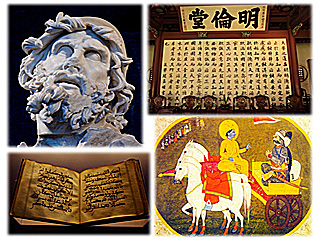Course Description
This course aims to introduce students to the rich diversity of human culture from antiquity to the early 17th century. In this course, we will explore human culture in its myriad expressions, focusing on the study of literary, religious and philosophical texts as ways of narrating, symbolizing, and commenting on all …
This course aims to introduce students to the rich diversity of human culture from antiquity to the early 17th century. In this course, we will explore human culture in its myriad expressions, focusing on the study of literary, religious and philosophical texts as ways of narrating, symbolizing, and commenting on all aspects of human social and material life. We will work comparatively, reading texts from various cultures: Mesopotamian, Greek, Judeo-Christian, Chinese, Indian, and Muslim. Throughout the semester, we will be asking questions like: How have different cultures imagined themselves? What are the rules that they draw up for human behavior? How do they represent the role of the individual in society? How do they imagine ‘universal’ concepts like love, family, duty? How have their writers and artists dealt with encounters with other cultures and other civilizations?
Course Info
Instructor
Departments
Learning Resource Types
assignment
Written Assignments

A collage of four images – (clockwise from top left) a sculpture of the head of Odysseus; Chinese calligraphy of The Great Learning in Confucianism; a painting of Krishna giving spiritual instructions (i.e. Bhagavad Gita) to Arjuna at Kurukshetra battlefield; and the Quran in Andalusi script – representing selections of classics across different cultures, regions, and time. (Photo credits, also clockwise from top left: public domain; courtesy of Fu-Min Yang, Asaf Braverman, UltraLeft on Flickr.)








